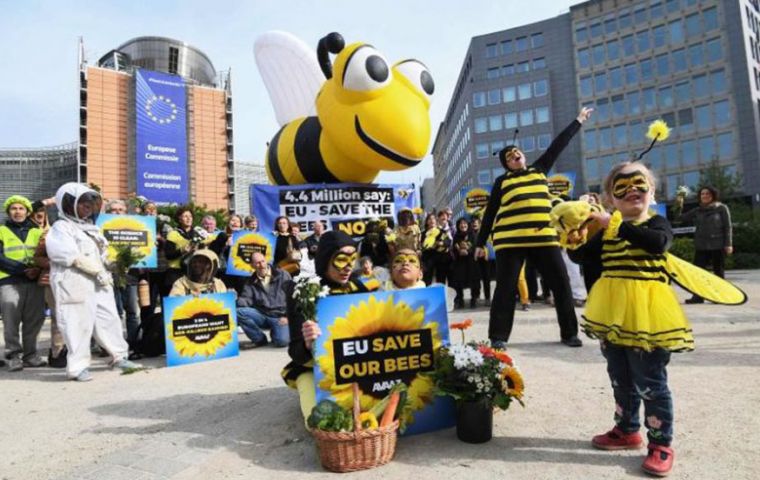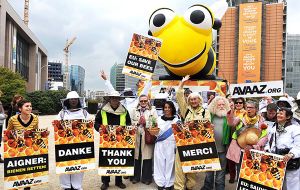MercoPress. South Atlantic News Agency
Bees victory: EU votes for a near total ban on insecticides
 Campaigners dressed in black and yellow bee suits rallied outside the headquarters of the EC in Brussels ahead of the vote for a ban on three key pesticide chemicals.(Pic AFP)
Campaigners dressed in black and yellow bee suits rallied outside the headquarters of the EC in Brussels ahead of the vote for a ban on three key pesticide chemicals.(Pic AFP)  The 28 EU member states approved a ban on three neonicotinoid pesticides after the European food safety agency said most chemicals posed a risk to honey bees
The 28 EU member states approved a ban on three neonicotinoid pesticides after the European food safety agency said most chemicals posed a risk to honey bees  EU Environment Commissioner Vytenis Andriukaitis said he was “happy that member states voted in favour of our proposal” to restrict the chemicals
EU Environment Commissioner Vytenis Andriukaitis said he was “happy that member states voted in favour of our proposal” to restrict the chemicals European Union countries voted on Friday for a near-total ban on insecticides blamed for killing off bee populations, in what campaigners called a “beacon of hope” for the winged insects. Bees help pollinate 90 percent of the world’s major crops, but in recent years have been dying off from “colony collapse disorder,” a mysterious scourge blamed on mites, pesticides, virus, fungus, or a combination of these factors.
The 28 European Union member states approved a ban on three neonicotinoid pesticides after the European food safety agency said in February that most uses of the chemicals posed a risk to honey bees and wild bees.
Campaigners dressed in black and yellow bee suits rallied outside the headquarters of the European Commission in Brussels ahead of the vote for a ban on three key pesticide chemicals.
EU Environment Commissioner Vytenis Andriukaitis said he was “happy that member states voted in favour of our proposal” to restrict the chemicals and tweeted a picture of the activists.
A Commission statement said EU states had “endorsed a proposal by the European Commission to further restrict the use of three active substances... for which a scientific review concluded that their outdoor use harms bees.”
The pesticides clothianidin, imidacloprid and thiamethoxam are based on the chemical structure of nicotine and attack the nervous systems of insect pests.
Brussels restricted their use in 2013 as part of efforts to protect bees and commissioned a deeper report into their effects, gathering all available studies on the issue.
Environmental groups, which have long campaigned for a ban on neonicotinoids, were abuzz about the decision.
“This comprehensive neonicotinoid ban, covering all outdoor crops, is a tremendous victory for our bees and the wider environment,’ said Sandra Bell, bee campaigner for Friends of the Earth Europe.
The Avaaz campaign group said that “banning these toxic pesticides is a beacon of hope for bees.” Unlike contact pesticides which remain on the surface of foliage neonicotinoids are absorbed by the plant from the seed phase and transported to leaves, flowers, roots and stems. They have been widely used over the last 20 years, and were designed to control sap-feeding insects such as aphids and root-feeding grubs.




Top Comments
Disclaimer & comment rules-

Read all commentsGreat job! Well done!
Apr 28th, 2018 - 01:17 pm 0The next step = the rest of the world, step-by-step?
Commenting for this story is now closed.
If you have a Facebook account, become a fan and comment on our Facebook Page!